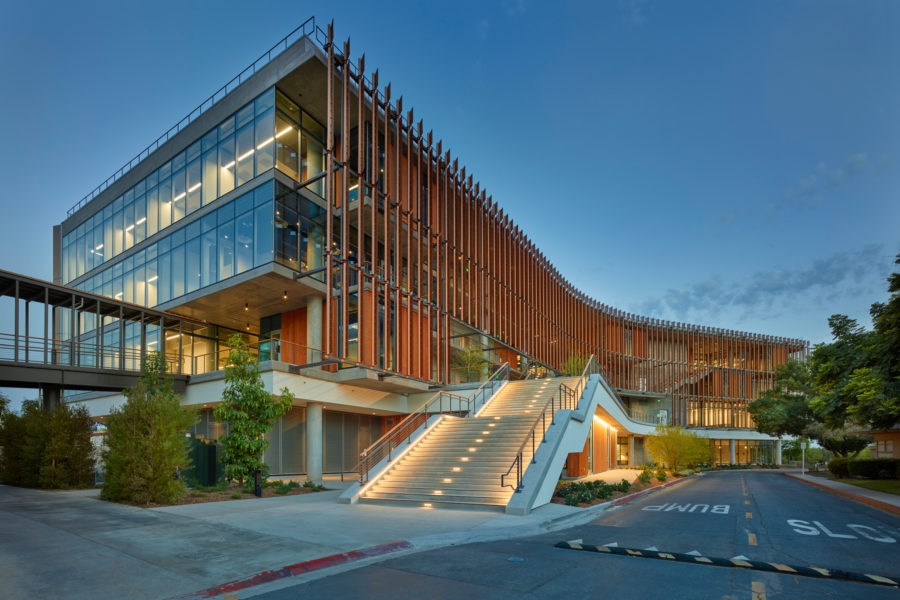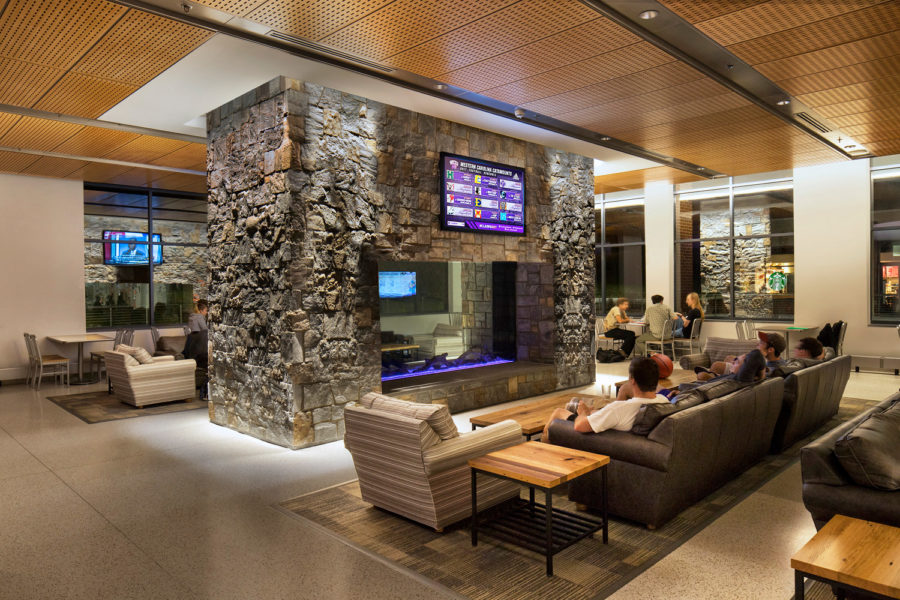Story at a glance:
- LEED and WELL certifications complement each other because LEED focuses on a building’s physical structure while WELL is concerned with the occupants.
- Certifying your building with one or both of these certifications adds market value to it as a green building.
- To keep your certifications current, recertify every three years.
Two popular green certifications available to builders of new structures or renovators of existing buildings are LEED (Leadership in Energy and Environmental Design) from the United States Green Building Council (USGBC), and WELL from the International WELL Building Institute (IWBI).
These building standards focus on different aspects of a building’s sustainability, as we’ll describe in this article.
What is LEED Certification?

The City of Hope administrative building is a four-story, 108,000-square-foot structure with an LEED v4 Gold Certification. Photo by Benny Chan, Fotoworks
LEED certification is the earned recognition conveyed by an independent, third-party certifier on behalf of the USGBC), a nonprofit organization founded in 1993, that certified that a building is green. Housed in a triply certified (LEED, TRUE, and WELL) platinum building in Washington, D.C., USGBC is currently preparing the next iteration of its standard, v5, expected in 2025.
The three major elements of LEED certification are decarbonization, indoor environmental quality, and resource efficiency in a building. These are delineated across seven categories listed below and followed by the maximum number of achievable points:
1. Sustainable Sites (26)
2. Water Efficiency (10)
3. Energy and Atmosphere (35)
4. Materials and Resources (14)
5. Indoor Environmental Quality (15)
6. Innovation in Design (6)
7. Regional Priority (4)
Applicants for this certification submit documents verifying, for example, the embodied carbon of their materials; the air and water quality in their building; and the energy use efficiency of their HVAC system as well as supporting evidence. They earn points (110 maximum) for meeting the various standards. Forty points is the minimum for a standard LEED certification. A silver LEED certification means a structure earned 50 or more points. LEED Gold certification is granted at 60+ points. Finally, the highest level, LEED Platinum, is achieved at 80 or more points.
None of the eligible points are weighted. For example, a building receives one point if it installs a bike rack. Remediating a brownfield site is also worth one point. Because LEED does not require monthly or annual data on how well a building’s energy system is functioning or how much water it is saving, it is not a performance-based tool. Rather, LEED is a design tool.
As the most widely used green building rating system in the world, some level of LEED certification has been achieved by more than 197,000 projects. The categories for LEED certification are:
Building Design and Construction (BD+C). New construction or major renovations; includes core and shell
Interior Design and Construction (ID+C). Includes fit-out projects
Building Operations and Maintenance (O+M). For existing buildings
Neighborhood Development (ND). New land development or redevelopment; residential, commercial, or a mix. Includes plan and built projects
Homes. Single-family, low- or mid-rise multi-family
Cities. Entire cities or parts of them
What is WELL Certification?

In Pittsburgh, Two Doughboy Square designed by Desmone Architects mixes contemporary and historical design elements and was one of the first in the region to receive a WELL Gold certificate. Photo by Ed Massery
Established in 2014 by the International Well Building Institute, a private company, more tahn 40,000 businesses are WELL-certified today. Like LEED, a third-party certifier conducts the review, but unlike LEED, there is an onsite evaluation.
Also in contrast to LEED, WELL concentrates on the building-human interaction and how the physical structure promotes social relationships among workers. Currently there are 10 metrics used in WELL certification:
1. Air
2. Water
3. Nourishment
4. Light
5. Movement
6. Thermal Comfort
7. Sound
8. Materials
9. Mind
10. Community
Similar to LEED, WELL operates on a point system (100 maximum). A bronze level means a structure earned 40 points. When 50+ points are attained, a silver WELL certification is granted. The gold level is achieved at 60+ points, and the platinum, at 80 points or more.
However, unlike LEED, WELL is a performance-based system. Both WELL and LEED certification holders must recertify every three years.
“WELL v2 strategies for air quality and monitoring were achieved, and the office contains three Kaiterra Sensedge monitors that measure and display PM2.5, PM10, TVOC, CO2, temperature, and humidity. These measures are monitored by staff so a high level of indoor air quality can be assured,” Madona Lizi Cumar-Malhotra, associate and designer at Perkins Eastman in Chicago, told gb&d in a previous interview about achieving WELL Platinum status.
How Do LEED and WELL Certification Metrics Compare?

Inside Brown Dining Hall, designed by Watson Tate Savory Architects, now part of McMillan Pazdan Smith Architecture. Photo by Gary Matson
Here are a few of the numerous standards or requirements of the LEED and WELL certifications that give you a better idea of how they differ. For more detail, consult the published standards available on the organizations’ websites.
Examples of LEED only standards:
● Site development – protect or restore habitat
● Sustainable sourcing of raw materials
● Disaster preparedness planning
● Renewable energy production
Examples of WELL only standards:
● Biophilic design
● Water quality testing
● HVAC humidity control
● Advanced Air Purification
Here are a few standards present in both LEED and WELL certifications:
● Indoor air quality management plan
● VOC reduction
● Air Filtration & Infiltration Management
Achieving or surpassing these standards in major renovations is also LEED-certifiable. For instance, Brown Dining Hall, on the campus of Western Carolina University, underwent a major renovation and earned LEED Gold. “The McMillan Pazdan Smith team successfully reused 94% of the building’s original structural elements. Of existing materials that were not reused, 98% were recycled,” Jane Hartenstine, a principal at McMillan Pazdan Smith, previously wrote for gb&d.
How Much Do LEED and WELL Certifications Cost?
For LEED, registration fees were $1,350 (members) and $1,700 (non-members) at the time of this reporting. Then there is a precertification flat fee of $4,500 or $5,600. Certification is calculated per square footage beginning at $3,200.
For WELL, at the time of this reporting, enrollment was $3,000. Certification is also calculated by square footage starting at $8,000 and capped at $98,000.
LEED vs WELL Certification
The LEED and WELL certifications complement each other, and, when earned together, showcase a building’s overall sustainability. While there is some overlap between these two green certifications, they are each unique enough to justify earning both of them. Since each one is multi-tiered, you will have something to work toward for many years until you reach each one’s platinum level.
Since each of these certifications raises public awareness of different facets of sustainability, they confer inestimable value on your structures when viewed together. Ultimately, the value of these certifications is in creating new markets and fostering innovation in sustainability.
Neither LEED nor WELL certification has any restrictions on what other certifications a building may have. To simplify the process, you can find out about streamlining the procedures of seeking both certifications in this USGBC FAQ page or on this IWBI website.



